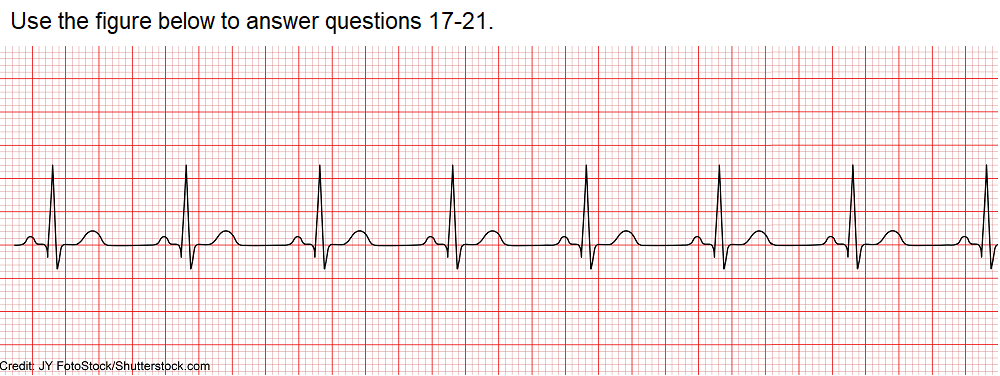ECG/EKG basic interpretation quiz for nurses!
This quiz will test your knowledge on how to analyze the PQRST complex on an ECG strip. You will be required to identify where atrial and ventricular depolarization and repolarization occur in the PQRST complex along with how the electrical conduction system works within the heart to cause the heart to contract.
As the nurse, it is important you are familiar with how to count the rate, determine if the rhythm is regular, measure the PR interval, QRS complexes, and how normal p-waves, ST segments, and t-waves should look.
If you are interested in learning more about ECG/EKG interpretation check out the series on YouTube. Don’t forget to review the ECG notes before taking this quiz.
ECG/EKG Interpretation Basics Quiz for Nurses

(NOTE: When you hit submit, it will refresh this same page. Scroll down to see your results.)
ECG/EKG Interpretation Basics Quiz for Nurses

1. When heart muscle cells are in the resting state they have what type of charge?
A. Negative
B. Positive
C. Neutral
D. Depolarized
The answer is A: negative
2. The process that causes a heart cell to contract is known as?
A. Repolarization
B. Polarization
C. Depolarization
The answer is C: Depolarization
3. When a heart muscle cell goes back into its negatively charged state, or in other words, when it relaxes this is known as?
A. Repolarization
B. Polarization
C. Depolarization
The answer is A: repolarization
4. Which part of the electrical conduction system is located in the upper part of the right atrium and is responsible for atrial depolarization?
A. AV node
B. Bundle of His
C. Purkinje Fibers
D. SA node
The answer is D: SA node
5. Once electrical signals pass through the Bundle of His, they next travel to?
A. AV node
B. Bundle branches
C. SA node
D. Purkinje Fibers
The answer is B: bundle branches
6. Select the characteristics of the AV node: (select all that apply)
A. It is known as the pacemaker.
B. It causes a delay in electrical signal transfer so the atria can fully empty into the ventricles.
C. It’s known as the gatekeeper.
D. It fires and sends impulses to cause atrial depolarization of the right and left atria.
E. It’s found in the lower part of the right atrium just above the tricuspid valve.
F. It’s found in the upper part the right atrium.
The answers are: B, C, and E
7. On an EKG/ECG strip each small square represents how many seconds of time?
A. 0.20 second
B. 0.02 seconds
C. 0.12 seconds
D. 0.04 seconds
The answer is D: 0.04 seconds
8. The nurse is assessing an ECG strip and counts 30 LARGE squares. How many seconds of time did the nurse count?
A. 30 seconds
B. 10 seconds
C. 6 seconds
D. 60 seconds
The answer is C: 6 seconds
9. Which part of the PQRST complex represents atrial depolarization?
A. P-wave
B. QRS complex
C. T-wave
D. ST segment
The answer is A: p-wave
10. The nurse is assessing an ECG strip and begins measuring at the beginning of the p-wave to the beginning of the QRS complex. What is the nurse measuring?
A. P-wave
B. ST segment
C. PR interval
D. PR segment
The answer is C: PR interval
11. Which part of the PQRST complex represents ventricular depolarization?
A. P-wave
B. QRS complex
C. T-wave
D. ST segment
The answer is B: QRS complex
12. Which part of PQRST complex represents ventricular repolarization?
A. QRS complex
B. ST segment
C. T-wave
D. P-wave
The answer is C: T-wave
13. What is the point where the QRS complex meets the ST segment?A. R-point
B. PR interval
C. QT interval
D. J-point
The answer is D: J-point
14. A normal PR interval should measure between?
A. 0.04-0.12 seconds
B. 0.20-0.36 seconds
C. 0.12-0.20 seconds
D. 0.35-0.40 seconds
The answer is C: 0.12-0.20 seconds
15. Select all the characteristics a normal p-wave should have?
A. One p-wave should accompany a QRS complex.
B. They should measure more than 0.36 seconds in duration.
C. P-waves should be flat.
D. P-waves should be round and upright.
E. Multiple p-waves can accompany a QRS complex.
The answers are A and D.
16. A QRS complex should measure no more than?
A. 0.20 seconds
B. 0.12 seconds
C. 0.08 seconds
D. 0.04 seconds
The answer is B: 0.12 seconds
17. Use the figure at the top of the quiz to answer the next few questions: What is the atrial rate?
A. 100
B. 90
C. 80
D. 60
The answer is C: 80
18. What is the ventricular rate of the rhythm above?
A. 100
B. 90
C. 80
D. 60
The answer is C: 80
19. What is the approximate measurement of the PR interval of the rhythm above?
A. 0.12 seconds
B. 0.20 seconds
C. 0.04 seconds
D. 0.08 seconds
The answer is A: 0.12 seconds
20. What is the approximate measurement of the QRS complex of the rhythm above?
A. 0.12 seconds
B. 0.20 seconds
C. 0.04 seconds
D. 0.08 seconds
The answer is D: 0.08 seconds
21. What is your interpretation of the rhythm above?
A. First degree heart block
B. Normal sinus rhythm
C. Sinus tachycardia
D. Atrial fibrillation
The answer is B: Normal Sinus Rhythm
Please tell your friends about this quiz by sharing this link to this quiz on your Facebook, Twitter, and other social media. You can also take more fun nursing quizzes.
*Disclaimer: While we do our best to provide students with accurate and in-depth study quizzes, this quiz/test is for educational and entertainment purposes only. Please refer to the latest NCLEX review books for the latest updates in nursing. This quiz is copyright RegisteredNurseRn.com. Please do not copy this quiz directly; however, please feel free to share a link to this page with students, friends, and others.